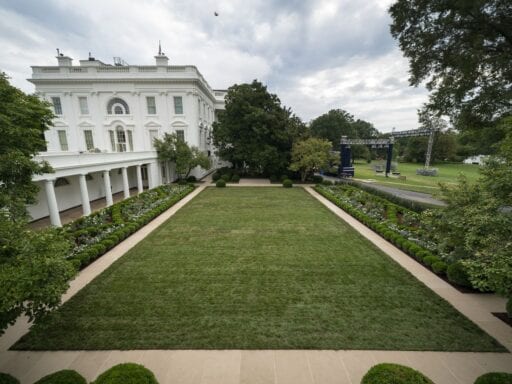She dug up trees and put in paved walkways.
Melania Trump unveiled her overhaul of the White House Rose Garden Saturday, a month-long project that included digging up trees, replacing vibrant floral beds with white and pastel roses and laying down paved walkways.
Beauty is in the eye of the beholder, but the decisions still sewed confusion online about how the “after” photos showed an improvement from the “before.”
Before and after photographs of newly renovated White House Rose Garden:
courtesy #Getty and @marycjordan pic.twitter.com/w6bzoNHMjC— Michael Beschloss (@BeschlossDC) August 22, 2020
Trump’s revamp was designed, in part, to “fulfill the dynamic needs of the modern presidency,” including making the space more amenable to TV cameras and other tech needs of the press corp. Donald Trump has begun holding press conferences in the garden rather than inside the briefing room in recent weeks because of Covid-19. It’s expected to the backdrop for Melania Trump’s Republican National Convention address on Tuesday, a controversial choice of venue that Democrats say is an illegal use of the White House grounds.
President John F. Kennedy, who commissioned the garden in 1961, approached the project with a somewhat similar thought, asking horticulturalist and gardener Rachel Lambert Mellon to design something “useful and attractive,” as he planned for it to be used near daily.
Mellon wrote a first person account for The White House Historical Association on designing and constructing the garden. Kennedy and the first lady had just returned from a trip abroad in the summer of 1961 to Europe and Australia, where the president “had recognized the importance of gardens surrounding an official residence and their appeal to the sensibilities of all people,” she wrote.
Crab apple trees were central to the design. Melania tore them out.
Mellon decided trees would be an important component to include in her design, for both aesthetic and practical reasons. (Washington is sweltering in the summer.)
One tree, a member of the rose family, anchored the long perimeter lines of the garden:
The trees we chose were Katherine crab apples. Crab apples belong to the rose family and would blend well with the roses, perennials, annuals, and herbs that would grow beneath and around them. Aware that the garden would be used almost every day of the year and that the President had high hopes for it, I decided to divide the long beds into sections. The design, with a crab apple as the center of each section, would repeat itself and run like a ribbon the length of both beds.
A large diamond-shaped outline of santolina would surround each crab-apple tree. Each diamond would be set in a larger outline: a small clipped English boxwood hedge and, next to the lawn, a low growing hybrid boxwood called Greenpillow, developed by Henry Hohman in Kingsville, Maryland.
Melania Trump dug them up. ABC reports the dozen trees will be replanted elsewhere on the White House grounds.
She did, however, introduce a three-foot-wide limestone walkway around the perimeter of the center lawn. (The White House said less-noticeable changes include improvements to make the garden more accessible for people with disabilities.)
The Trumps paved paradise and put up a parking lot. https://t.co/XVLthzu37f
— The Daily Edge (@TheDailyEdge) August 22, 2020
Melania also swapped out the colorful tulips and other bright perennials and annuals in Mellon’s design for white and pastel roses and sharp boxwood hedges. Mellon said Kennedy had asked for the vibrant look. “The President loved flowers and asked if a variety of other types could be mixed with the roses. He had read the published garden notes of Thomas Jefferson and hoped for flowers used in Jefferson’s period,” she wrote.
There are more important things than gardens
The changes to the Rose Garden struck a nerve on Saturday, with outrage tweets dominating Twitter. Why, many critics asked, did Melania need to change the design at all? And why take out trees? Why make the flowers less vibrant?
Still, many conceded that there are more things to be mad about in Washington these days than landscaping. There’s the failed White House response to the pandemic that has left 200,000 Americans dead, according the the New York Times. There’s the fact that Republicans in the Senate have no plan to pass a bill to help millions of workers who’ve been left unemployed because of Covid-19.
Perhaps, though, amid a dark moment, one where we’re all looking for a little good news and a flicker of hope that our leaders might just help us get through it, to see the White House take away a patch of brightness feels bigger than it otherwise would.
Author: Laura McGann
Read More



